Animals With Big Eyes| Facts and Pictures
Animals with big eyes hold an undeniable fascination for us. Their captivating gaze often enchants and draws us into their world, inviting us to explore the mysteries and wonders of nature. These creatures possess a unique charm, effortlessly captivating our attention and sparking our curiosity.
In this article, we will delve deeper into the fascinating world of big-eyed animals and explore the significance behind their enchanting eyes.
Example Of Animals with Big Eyes
Here are 15 animals renowned for their big, charming eyes, spanning across various species, including mammals, reptiles, and amphibians.
Tarsiers
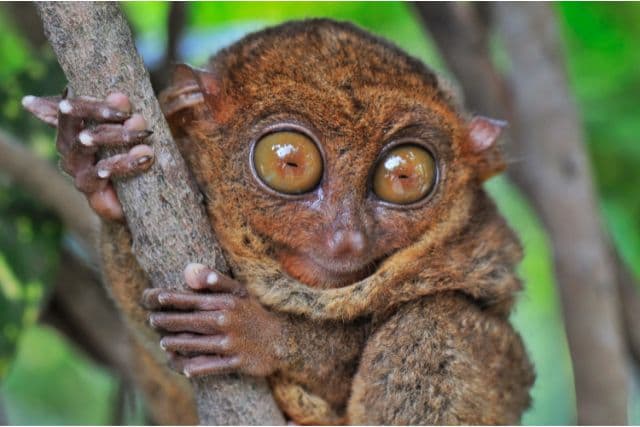
These animals with big eyes are undeniably adorable. They are called tarsiers due to their elongated ankle bone, known as the “tarsus”. Tarsiers possess remarkably large eyes, with each eyeball measuring approximately 16 millimeters (0.63 in) in diameter.
In fact, their eyes are as big as, or sometimes even larger than, their entire brain. Unlike other animals, tarsiers have fixed eyes in their skull and cannot move them within their sockets.
However, they have a unique adaptation in their neck that enables them to rotate their round heads by 180°. Tarsiers have disproportionately large eyes compared to their body size, making them possess the highest eye-to-body weight ratio among all mammals.
These enormous eyes grant tarsier’s exceptional night vision. When exposed to bright light, their eyes can narrow until the pupil appears as a mere thin spot. Conversely, in dim light or darkness, the pupil can expand and occupy almost the entire eye.
Read Also: Animals With Big Ears
Slow Loris

The slow loris is known for its adorable appearance, with big saucer eyes and a small face. However, don’t be deceived by their cute looks. Their bite can be quite dangerous due to the venom it carries, which can cause a flesh-rotting condition.
Interestingly, recent studies have revealed that other slow lorises are the ones most affected by their bites. Despite this, slow lorises are not inherently dangerous creatures. They have a deliberate and slow movement, and when faced with a threat, they tend to stay still and patiently wait for the danger to subside.
Zebra Black Spider
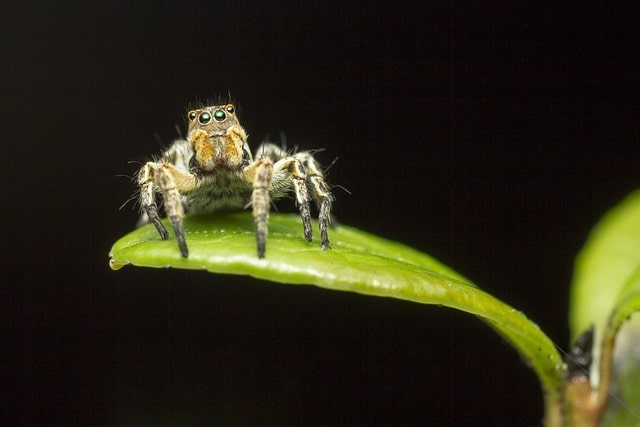
The zebra black spider is a tiny creature that can be found on our planet. It has a compact body and short legs, with black color and white stripes. Interestingly, this spider has relatively large eyes compared to its body. These eyes are the most prominent feature on its face and are completely dark.
Surprisingly, this spider actually has a total of eight eyes. The primary ones, which are the biggest, are located in the front of its head and allow it to have binocular vision. The remaining six eyes are positioned on the sides of its head, granting the spider a remarkable 360-degree panoramic view of its surroundings.
Read Also: Animals with Long Necks
Ostrich

The ostrich possesses the biggest eyes among all land animals. With a diameter of two inches, their eyes are approximately the size of a pool ball and five times larger than those of humans.
Interestingly, the eyes occupy such a significant space in the ostrich’s head that its brain is smaller than its eyeballs. This remarkable eyesight allows the bird to detect objects as far as two miles away during daylight. Such keen vision serves as a defense mechanism against predators.
Since ostriches can reach speeds of up to 45 miles per hour, spotting their enemies early provides them with a valuable advantage!
Tokay Gecko

The Tokay Gecko is quite unique among lizards. Unlike most lizards, it is nocturnal and has exceptional night vision. In fact, its color vision in low light is 350 times more sensitive than human eyes! Interestingly, geckos don’t have eyelids like other lizards. Instead, they have a transparent membrane called the cornea on the outer surface of their eyeballs. Additionally, they have a fixed lens within each iris that expands in darkness to allow more light in.
One of the standout features of the Tokay Gecko is its vocal abilities. It is named after the distinct sound it makes, which can be described as “to-kay, to-kay.” This call echoes through the night, making it quite renowned for its vocal prowess. But that’s not all! This gecko also possesses specialized toe pads that are truly remarkable. These pads have microscopic hairs that enable the gecko to effortlessly climb vertical surfaces and even move across ceilings with ease. It’s truly a fascinating creature!
Read Also: Animals Without Blood
Pygmy Marmoset Monkey
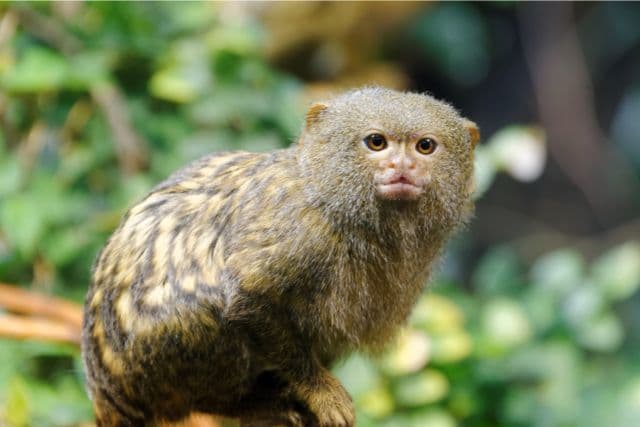
The Pygmy Marmoset Monkey is a fascinating creature found in the forests of South America. It moves with the agility of a squirrel, darting and freezing in its surroundings. Despite its small size, this mini-monkey has remarkable eyesight that helps it spot predators and find food.
Interestingly, its eyes are wider on its face rather than being big. These expressive animals use their eyes and tufts to convey emotions like fear, surprise, and playfulness.
These miniature monkeys are known for their arboreal lifestyle and are skilled climbers. They effortlessly leap from branch to branch in search of insects, fruits, and tree sap, which make up their primary diet. Their small size allows them to navigate the intricate canopy with ease, avoiding larger predators.
Owl
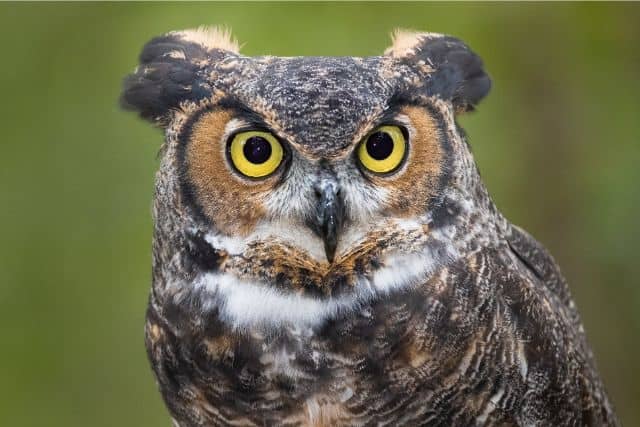
When you think of animals with big eyes, the first one that often comes to mind is an owl. Owls have incredibly large eyes that help them see in extremely low levels of light, making them excellent hunters.
However, there are rumors that owls cannot see in complete darkness. Interestingly, owls have better night vision than even felines. The Great Grey Owl, for example, has huge black pupils that give it superior vision compared to other nocturnal animals.
Another fascinating fact about owls is that they cannot move their eyes. They can only see directly in front of them at all times, so they have to turn their heads to look to the sides.
Read Also: Animals Without Teeth
Gray Mouse Lemurs

The gray mouse lemurs possess large, noticeable eyes and a tapetum lucidum, a layer of tissue in their eyes that enhances their night vision. These lemurs usually search for food alone during the night, scurrying around like mice and leaping over distances of up to 3 meters (9.8 feet), using their tails to maintain balance.
When they are on the ground, whether it’s to catch insects or cross short open areas, gray mouse lemurs hop like frogs. During hunting, they primarily rely on their vision to spot their prey and then swiftly grasp invertebrates and small vertebrates with their hands.
Dog

The term “puppy eyes” refers to the sad, curious, and big-eyed gaze that many dog lovers find irresistible. Research indicates that dogs typically have eyes similar in size to humans, with only the cornea being larger in diameter, resulting in a larger iris. This particular feature allows dogs to create incredibly expressive stares. Additionally, dogs possess a tapetum lucidum, a reflective layer in their eyes that causes them to shine at night.
Among the different dog breeds, pugs generally have the largest eyes. However, according to the Guinness Book of World Records, the dog with the biggest eyes in the world is a Boston terrier named Bruschi.
Rabbits

Rabbits have a wide range of eye colors, although they typically have dark eyes. However, albino rabbits always have red eyes. What’s interesting about rabbit eyes is not just their color, but also their incredible abilities. Their eyes are large in proportion to their body size, and they are positioned on opposite sides of their head. This gives them a panoramic field of vision, allowing them to see 360 degrees without having to turn their heads. They can even see above their heads!
Surprisingly, the only blind spot for rabbits is right in front of them. But don’t worry, their keen sense of smell and their whiskers make up for this limitation. Another fascinating fact is that rabbits sleep with their eyes open. They only close their eyes when they feel completely safe in their environment.
Read Also: Animals with Feathers
Colossal Squid

The colossal squid is truly a marvel of the deep sea. Found in the icy waters of Antarctica, it holds the title of being one of the largest creatures on Earth. Not only is it the largest invertebrate known to man, but it even surpasses the size of the mighty whales that roam its habitat.
Interestingly, the colossal squid’s presence is evident in the scars found on sperm whales, indicating fierce battles between these two giants. What set this creature apart is its remarkable eyes, which are positioned forward, allowing it to have excellent depth perception. In the dimly lit depths, these soccer ball-sized eyes help the colossal squid locate its prey and stay vigilant against potential predators.
Senegal Bushbaby

The Senegal bushbaby, also known as the galago, is a small primate that is active during the night. With their large eyes, they have excellent night vision, and their bat-like ears help them locate insects in the dark. These agile creatures are fast and can catch insects on the ground or in mid-air. Not only are they playful, but they also enjoy swinging from branches and climbing high. They engage in play fights, grooming, and following-play, where they jump and chase each other through the trees.
Panther Chameleons

The eyes of panther chameleons are truly unique among reptiles, functioning like a gun turret. Their upper and lower eyelids are fused together, leaving only a tiny opening for the pupil to peer through. These remarkable creatures have the ability to rotate and focus their eyes independently, allowing them to observe two different objects at once. This gives them an incredible 360-degree field of vision around their bodies.
When they spot their prey, both eyes can lock onto the same target, providing them with sharp stereoscopic vision and depth perception. Panther chameleons possess exceptional eyesight for reptiles and can spot tiny insects from a remarkable distance of 5-10 meters!
Margay

Margays possess large eyes strategically positioned to grant them binocular vision. Their night vision is exceptional, thanks to the tapetum lucidum, a tissue layer in their eyes that reflects light back into the eyeball, giving felid eyes their distinct shine.
Consequently, these wild cats have eyes that are approximately six times more light-sensitive than those of humans. Margays predominantly inhabit trees, but they also traverse the ground, particularly when transitioning between hunting grounds. Throughout the day, they seek refuge in secluded branches or clusters of lianas.
What sets this small wild cat apart is its ability to imitate the vocalizations of a pied tamarin infant while hunting! This behavior represents the first recorded instance of a Neotropical predator utilizing such mimicry.
Read Also: Lazy Animals In The World
Tree Frog

Last but not least, let’s talk about animals with big eyes! The tree frog is one of them. Their eyes stick out from their heads, giving them a unique and almost otherworldly appearance. This interesting feature serves as a defense mechanism. It’s called “startle coloration.”
When the tree frog closes its eyes, its eyelids and body blend perfectly into their leafy surroundings. But if a predator comes too close, the frog will open its eyes, and the sudden sight of those large eyes can temporarily paralyze the predator. In that split second, the frog can make its daring escape.
FAQs About Animals With Big Eyes
Why Do Some Animals Have Big Eyes?
Animals with big eyes have evolved to adapt to their environments. Larger eyes can enhance vision in low-light conditions, help detect predators, and even express complex emotions.
What animal has big eyes that live in trees?
The tarsier is an animal with big eyes that lives in trees. Native to Southeast Asia, these small primates are adapted for a tree-dwelling lifestyle and are known for their disproportionately large eyes, which aid them in hunting and navigating their forest habitats.
Do big eyes make animals more expressive?
Absolutely! The size and expressiveness of an animal’s eyes often correlate with its ability to communicate. From joy to fear, the eyes convey a myriad of emotions, forming a universal language in the animal kingdom.
What Are Some Common Animals With Big Eyes?
The animal kingdom boasts a diverse array of big-eyed animals. From the captivating gaze of the owl to the endearing eyes of the bush baby, examples abound across various ecosystems.
Can big eyes be a disadvantage?
Surprisingly, yes. While big eyes offer advantages, they can also be vulnerability. Some prey animals with large eyes may struggle with camouflage, making them more susceptible to predators. It’s a delicate balance in the circle of life.
Conclusion
In conclusion, with animals with big eyes, nature is a fascinating spectacle. From the night vision of tarsiers to the calculated stillness of slow lorises, each species reveals unique adaptations. Rabbits’ panoramic vision, dogs’ expressive stares, and panther chameleons’ 360-degree eyesight showcase the diversity of these enchanting creatures.
As we marvel at the colossal squid’s depth perception and the Tokay Gecko’s vocal prowess, it’s clear that big eyes play multifaceted roles—from survival to communication. This journey into the animal kingdom provides a glimpse into the artistry of nature and the captivating charm residing in the eyes of these mesmerizing beings.
Animals With Big Eyes | Facts and Pictures
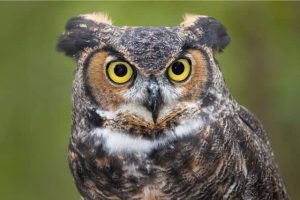
Title: Animals With Big Eyes | Facts and Pictures
Description: Discover the enchanting world of animals with big eyes! Explore fascinating facts and captivating pictures of 15 adorable creatures, from tarsiers to owls. Uncover the significance behind their mesmerizing gaze and learn how big eyes contribute to their survival. Dive into the diverse realm of nature's wonders in this informative journey.
Start date: December 21, 2023
Author: Muhammad Ali
-
Quality - 94
-
Information - 95
-
Content - 96
-
Writing Style - 97
-
Awesomeness - 98
Summary
In summary, the world of animals with big eyes is a captivating tapestry of nature’s wonders. From the enchanting gaze of tarsiers to the calculated stillness of slow lorises, these creatures showcase the diversity of life. Whether it’s the panoramic vision of rabbits, the expressive stares of dogs, or the depth perception of panther chameleons, each species reveals a unique adaptation shaped by evolution.
As we marvel at the incredible eyes of the colossal squid, the acrobatic prowess of pygmy marmoset monkeys, and the vocal talents of the Tokay Gecko, it becomes clear that big eyes serve various purposes in the animal kingdom. Beyond their visual significance, these eyes convey emotions, aid in survival, and contribute to the intricate dance of predator and prey.
So, the next time you encounter an animal with big eyes, remember the stories hidden within those orbs—stories of adaptation, communication, and survival. Our journey into the world of these mesmerizing creatures offers a glimpse into the artistry of nature and the undeniable charm that resides in the eyes of the animal kingdom.